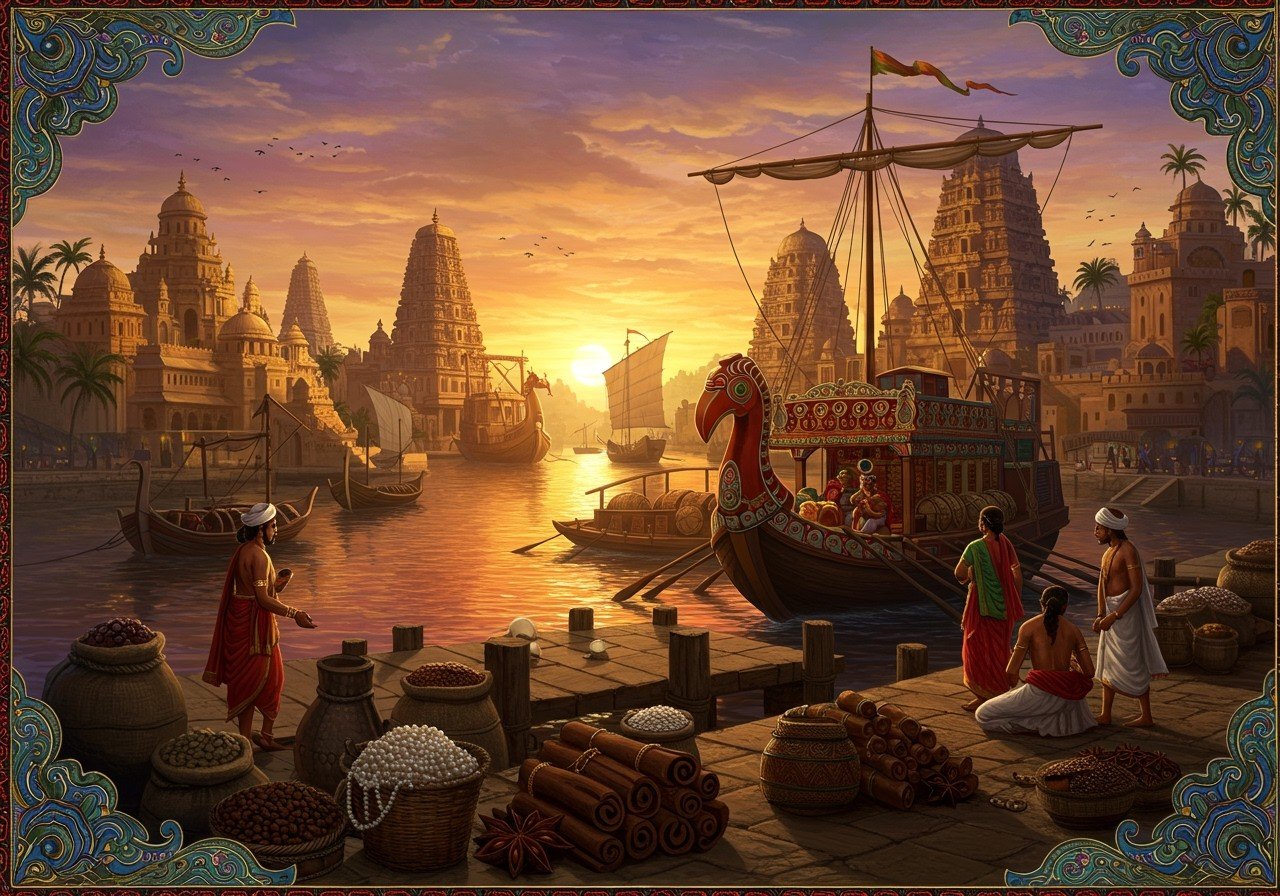Introduction

The Pandya Empire, a prominent ancient South Indian dynasty, prospered due to its robust economy and far-reaching trade networks. Renowned for their maritime expertise, the Pandyas became a major trading force in the Indian Ocean. This article delves into the economic strategies, trade routes, and the crucial role of ports in the Pandya Empire’s success.
Inland Trade Routes
The Pandya dynasty possessed significant trade routes, both inland and maritime. Key inland routes included the Cumbum Pass and Thandikudi. These routes facilitated the movement of goods within the empire and to neighboring regions, playing a vital role in connecting different parts of the empire and fostering economic integration.
Roman Trade Connections
The Pandyas actively traded with Roman merchants, who harnessed the monsoon winds to reach ports in Kerala. This interaction with Roman traders highlighted the empire’s strategic location and maritime capabilities. The exchange of goods with the Romans encompassed a variety of commodities, including spices, textiles, pearls, and precious stones, enriching both empires.
Broader Tamil Network
The Pandyas were an integral part of a larger network of Tamil kingdoms, including the Chera and Chola dynasties. This network broadened their trade connections, extending their reach to the Roman Empire, Southeast Asia, and East Africa. These interactions not only boosted trade but also fostered cultural exchange and diplomatic ties, enriching the Pandya Empire’s cultural landscape.
Role of Merchant Guilds
Merchant guilds held a pivotal role in the Pandya dynasty’s trade practices. These guilds ensured smooth transactions, maintained quality standards, and facilitated connections with foreign traders. Their organized structure and established practices contributed significantly to the efficiency and trustworthiness of the empire’s trade networks, fostering economic stability and growth.
Archaeological Findings
Archaeological discoveries of Pandya coins underscore their historical significance. These coins, often bearing distinct designs and inscriptions, reflected the economic policies of the rulers. The use of currency streamlined trade by establishing standard values for goods and services, promoting transparency and fairness in commercial exchanges.
Cultural Exchange Through Trade
Trade interactions fostered the exchange of ideas, art, and religious practices. Port cities within the Pandya Empire transformed into multicultural centers due to the influx of foreign traders. This cultural diversity fostered social harmony and contributed to the development of urban centers, enriching the empire’s social fabric and promoting intellectual and artistic growth.
Modern Ritual Items Reflecting Pandya’s Trade Legacy
Poojn.in offers traditional items that connect to the rich trading heritage of the Pandya Empire. Explore these offerings and connect with the historical significance of this era:
-
Copper Items: The copper Ananda Kosha Kushi Bhoj Patra (550 gm, 11-inch) available on our platform represents the metal craftsmanship similar to what the Pandyas traded. These vessels maintain the same pure copper quality that made Pandya’s metalwork famous in international trade, offering a tangible link to the past.
-
Clay Items: Our handcrafted clay pots (10-inch) with hand-printed designs reflect the pottery traditions that were part of Pandya’s domestic and international trade. Items like the Hadi Kundo and Hari Patil with Dhakkan showcase the enduring legacy of South Indian craftsmanship, preserving ancient techniques and artistic styles.
-
Traditional Ritual Items: The Varanasi-made traditional Sindur Dibbi and Lakshmi Kouto in our collection represent the north-south trade connections prevalent during the Pandya period. Similarly, the Astadhatu (eight-metal alloy) Lakshmi idols reflect the advanced metallurgy that made Pandya ports vital trading hubs, showcasing the empire’s technological and artistic prowess.
These items are available for direct purchase through our website, offering the same convenience that made Pandya ports crucial trading centers, now adapted for the digital age.
Conclusion
The Pandya Empire serves as a prime example of ancient maritime power and economic innovation. Their strategic utilization of ports, robust inland trade routes, and active engagement with international traders demonstrate their exceptional trading capabilities. The legacy of the Pandya rulers’ economic policies and their lasting impact on cultural and social aspects of life continue to resonate in South Indian traditions. Understanding this rich history provides valuable insights into the history of global trade and its profound impact on civilizations.
FAQs on Pandya Empire Economy & Trade: A Maritime Powerhouse
What were the major ports of the Pandya dynasty?
The major ports of the Pandya dynasty included Korkai, Saliyur, Kayal, and Alagankulam, facilitating trade and cultural exchange across vast distances.
How did the Pandya dynasty conduct trade?
The Pandya dynasty conducted trade through well-established ports along the coast, engaging in maritime trade with regions like Rome, Greece, and Southeast Asia, establishing extensive networks and economic partnerships.
What goods did the Pandya dynasty trade?
The Pandya dynasty traded various goods, including pearls, spices, ivory, textiles, and precious stones, reflecting the diverse resources and craftsmanship within their empire.
What type of coins did the Pandya dynasty use?
The Pandya dynasty primarily used silver and gold coins, often featuring the fish emblem, a symbol of their kingdom, demonstrating their established monetary system and economic power.
Why was the Pandya dynasty considered a maritime powerhouse?
The Pandya dynasty earned the title of maritime powerhouse due to their strategic coastal ports, advanced shipbuilding techniques, and vast trade networks spanning across several continents, establishing their dominance in the Indian Ocean.
What role did the Pandya dynasty ports play in their economy?
Pandya dynasty ports were crucial to their economy, facilitating trade, attracting merchants from diverse regions, and enabling the export of local goods, driving economic growth and prosperity.
How did the Pandya dynasty influence trade in South India?
The Pandya dynasty significantly influenced trade in South India by establishing strong maritime connections, promoting commerce, and creating a thriving economic environment that benefited the entire region, leaving a lasting legacy of trade and prosperity.


